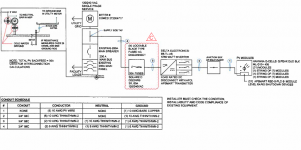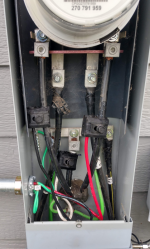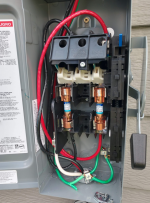We just adopted the 2020 NEC and I have a question related to the PV switch, requirement of NEC 250.25 Neutral to case bond. As has been discussed in this forum at length before  , although, it made sense a utility line side tap would cause the PV switch to be service equipment, it was unclear in the 2017 NEC if the N/G bond was required.
, although, it made sense a utility line side tap would cause the PV switch to be service equipment, it was unclear in the 2017 NEC if the N/G bond was required.
I have a question regarding the PV switch GES/GEC requirements. We (I) never installed solar in my career, but am responsible for inspecting PV systems now. I included a one-line drawing of a common residential system I see in our area. Utility here does not allow the tap in the meter any longer, so what I see now is the line side tap ahead of the main in the MDP. (the pic is a meter line side tap- didn’t have one in the MDP) The typical installation from the PV switch is bonding bushings EGC’s back to the MDP. (see pics) In my area all installations are mostly “pipe and wire” the MDP’s presently are inside the residence and a N/G case bond at the MDP.
My question is since the PV switch outside now gets a N/G case bond per 250.25, are you required to also bond to the water ground and all other available electrodes and if so, how is that typically accomplished to satisfy code requirements. Separate GEC’s to electrodes?
In my area there are typically bonding bushings on the line side nipples – Meter to MDP, (GEC electrodes (rods) N/G bond to meter case – this is a utility requirement) N/G bond MDP – where Water GEC and UFER GEC if present would land. I realize the EGC bonds will now stop at the PV switch.
I have a question regarding the PV switch GES/GEC requirements. We (I) never installed solar in my career, but am responsible for inspecting PV systems now. I included a one-line drawing of a common residential system I see in our area. Utility here does not allow the tap in the meter any longer, so what I see now is the line side tap ahead of the main in the MDP. (the pic is a meter line side tap- didn’t have one in the MDP) The typical installation from the PV switch is bonding bushings EGC’s back to the MDP. (see pics) In my area all installations are mostly “pipe and wire” the MDP’s presently are inside the residence and a N/G case bond at the MDP.
My question is since the PV switch outside now gets a N/G case bond per 250.25, are you required to also bond to the water ground and all other available electrodes and if so, how is that typically accomplished to satisfy code requirements. Separate GEC’s to electrodes?
In my area there are typically bonding bushings on the line side nipples – Meter to MDP, (GEC electrodes (rods) N/G bond to meter case – this is a utility requirement) N/G bond MDP – where Water GEC and UFER GEC if present would land. I realize the EGC bonds will now stop at the PV switch.




